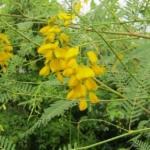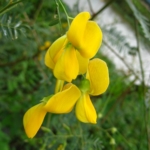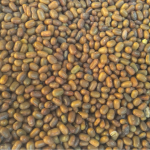-
International
With a presence in Asia, Africa, Australia and the Pacific, the Caribbean, and the United States; working with both small farmers and large enterprises we are never too far from your needs. -
-
TROPICAL SEEDS, LLC
2175 NW 24TH AVE.
MIAMI, FLORIDA 33142-7279
USA
Phone: +1 954 7536301
-
Sesbania
Sesbania sesban (L.) Merr.
Strengths:
Rapid establishment and early growth High nutritive quality for ruminants Acid-soil, waterlogging and salinity tolerances Native to or naturalized in Africa, Asia and Australia Grows in a wide range of soils from loose sands to heavy clays
Uses:
Long history of use in India, primarily as a green manuring and a source of cut-and-carry forage. Can be intercropped with corns, beans, cotton and other field crops. Leaves are a good source of protein for cattle and sheep. Used as a grazed forage in sub-tropical Australia and Kenya . Used as a reclamation species of saline soils in Southern China. Produces a light fuel wood suitable for cooking and charcoal production. Used as a live support for black pepper, grapes, cucurbits and betel vine and as a shade tree for coffee and turmeric.
Soil requirements:
Tolerates saline soils (1.0% salt concentration in the seeding stage to 1.4% at maturity), alkaline soils (pH<10), and acidic soils, as well as waterlogging and flooding. Tolerant of low P, but P application has a positive effect on growth and nodulation. . Tolerant of metalliferous mine tailing high in Cu,Zn and Pb. Moisture: Native to monsoonal, semi-arid to sub-humid regions with 500-2,000mm annual rainfall. Grows best where periodic waterlogging or flooding is followed by a progressive drier season.
Temperature:
Tolerant of cool highland-tropical or sub-tropical conditions, growing at up to 2,300 m altitude in Kenya and as far as south as 27° latitude in Australia. Average annual temperatures ranging from 17-20°C. Tolerates light frosts, but will be killed by heavy frost. Has moderate shade tolerance. Flowering is prolific and will occur within 12 months of sowing. It is photoperiod sensitive, flowering into short days(peak flowering occurs in April-May in Queensland, Australia).Seeds matures in 2-3 months.
Defoliation:
Normally used as a cut-and-carry species. With appropriate cutting management will persist for up to 5 years. Can be cut after the plant reaches 1-2 m height. Delaying cutting until the plant is >4 m tall, and low cutting at <50 cm, will result in plant deaths. Best results are achieved when it is cut to 75-100 height and some foliage is retained. Can be defoliated up to 5 times /year depending on use and environment. Direct grazing by cattle will result in considerable breakage of stems, but regrowth below the break is rapid. Direct grazing by goats resulted in 80% mortality because of ring-barking 8-20 cm above ground level. It is browsed by ruminants in its native range.
Establishment:
As a fence, it is planted at 1-2 m spacing in single rows, as an alley crop, single or double rows are planted 2-10 m apart, with plants spaced 25-50 cm apart within rows. As a protein bank, it is planted in rows 1-2 m apart with plants spaced 25-50cm apart within rows. Nodulates readily with native Rhozobia and Inoculation is not generally required. Its rapid early growth generally enables it to overcome weed competition easily and weed management is generally not required. Scarification of seed is required to achieve uniform germination, although many publications report no requirement for scarification. Ninety –nine percent germination of a seed lot was achieved at 3-24 days after sowing. Seed should be acid or abrasively scarified in preference to hot-water scarification as the latter results in large percentages of non-viable seed. Grown in hedgerows 2-10 m apart with crops or pasture grasses In the interrows. Its rapid growth can prove overly competitive with understory companion crops. Will not spread under grazing. May have some potential to spread in ungrazed situations.
Nutritive value:
Crude protein content ranges from 25-30% of DM. Digestibility varies considerably among accessions depending on polyphenolic compounds present and their concentrations. High N intake, high N retention and moderate faecal N, making it a useful source of protein for ruminants.
Palatability:
Moderately well accepted by ruminants in cut-and – carry feeding systems. Under direct grazing in Queensland, Australia, young, novice cattle were slow to accept Sesbania, taking about 3 months to become fully accepting of the forage. Subsequent liveweight gains were excellent.
Toxicity:
Sesbania does not contain condensed tannins, but does contain phenolic compounds including saponin which has spermicidal and haemolytic activity and was found to depress feeding activity in moth larvae. The inclusion of Sesbania in poultry diets (10% of diets) proved fatal to young chicks.
Dry matter:
Sesbania has an advantage over most other Tree forages in its rapid establishment. It was reported to attain a height of 4-5 m at 6 months after planting in India and produced 4 times the forage yield of Leucaena Leucocephala at 3 months after planting in Australia. Under favourable conditions DM yields of up to 20 Ton/ha/year ranging from 30-60% depending on cutting frequency and growing conditions. Seed production can be as high as 1-2 ton/ha. Very susceptible to insect attack and should not be stored for more than 1 year.
-
TROPICAL SEEDS, LLC
2175 NW 24TH AVE.
MIAMI, FLORIDA 33142-7279
USA
Phone: +1 954 7536301









